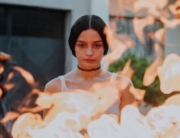The 2023 Toronto International Film Festival scored a coup for its opening night film, Hayao Miyazaki’s long-anticipated The Boy and the Heron. Alberto Barbera of the Venice Film Festival wanted it, and presumably so did Telluride. At the time of the selection announcement, the Studio Ghibli–produced feature was reportedly the anime master’s final work. The day after its Toronto premiere, Studio Ghibli vice-president Junichi Nishioka announced that the director would continue to write. That’s promising news because otherwise his filmography would conclude on a muted note.
Without a doubt, the 82-year-old Miyazaki pulls out all stops visually in perhaps his most beautiful movie. His fantastical worldbuilding keeps on expanding throughout the two-hour running time. His signature forest greens are all here, as well as a grotesque shapeshifter (the Heron), an army of frogs, and adorable creatures, little fluffy fur balls (pre-humans) called the Warawara. The visuals will keep viewers in their seats while the storyline meanders toward a cul-de-sac.
The saga begins with an inferno in 1937 Tokyo, in which a hospital fire claims the life of the mother of eight-year-old Mahito (voiced by Soma Santoki). Fast forward four years later and the boy and his father leave the big city for a bucolic setting—though not safe from danger, as they will find out. Arriving at the train station, the square-jawed father springs news on his son: they will live with father’s new wife, Natsuko (Yoshino Kimura), his first wife’s lookalike sister—who is also pregnant.
Seven cuddly crones run the household and look after the boy. (The crankiest one is always on the lookout to bum a cigarette.) Behind his new home lies a dark forest and a decrepit, ivy-covered tower, with a maze of tunnels underneath, built by the stepmother’s great uncle. Lurking outside at Mahito’s bedroom window is a squawking beady-eyed Heron (Masaki Suda), who has a message: His mother isn’t dead. She’s waiting for her rescue. Additionally, the boy will have to undertake a dual mission: to find his stepmother, who has gone missing. Natsuko was last seen entering the forest and heading toward the mysterious tower.
To continue describing the synopsis would involve adding one subplot on top of another, followed by “and then” … “and then” … “and then.” The narrative doesn’t stop developing, throwing new characters and themes onto the screen almost up to the last minute. It’s not until the final half hour that the most threatening villains appear on screen, barrel-chested parakeets that take over the tower.
Instead embarking on a hero’s journey, Mahito is portrayed more like a pinball knocked about and rescued from harm by others. Out of loop with the strange landscapes he encounters, he is a passive stand-in for the audience. (He’s not Spirited Away’s plucky Chihiro. That film would be a stronger entry point for Miyazaki newcomers.) Two of his saviors are Kiriko (Ko Shibasaki), a can-do fisherwoman, and Hiri (Aimyon), a fire maiden, as well as the Heron, after he and Mahito learn to trust and work together on the search.
Mahito may be Miyazaki’s least compelling protagonist of all his films. He’s completely upstaged by the supporting cast, and his search for his missing stepmother comes across as perfunctory. The boy has barely gotten to know Natsuko, and has not embraced her as a parent, before she goes off wandering into the forest. His father dashes in and out, as though he has custody of his son only on the weekends. Emotional resonance is not part of the movie’s magic. Like the sinking bottom floor of the tower that drops Mahito into an alien universe, the story doesn’t have a solid foundation.
Still, for the director’s fans and many viewers, the dazzling color palette and Miyazaki’s imagination may win out over a long-winded saga—especially if you accept it as feverish dream. Hopefully, it will not be Miyazaki’s last hurrah.
The Boy in the Heron will open theatrically in the United States on December 8.







Leave A Comment